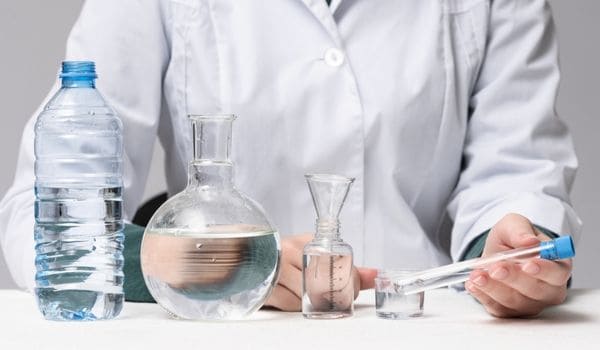Volatile organic compounds — VOCs for short — are synthetic chemicals that have a sneaky habit of ending up where they don’t belong. Like your water glass.
They show up in everything from glue and pesticides to gasoline and old carpeting. These compounds weren’t made for drinking — yet somehow, they’re popping up in both well water and city taps all over the place.
And here’s the kicker: they move fast, they evaporate into the air, and they don’t always leave a clue behind. No weird taste. No funky smell. But the health risks? Very real.
🧪 Key Takeaways
- 💨 VOCs are airborne chemicals that can dissolve into water
- 🚱 They often enter wells and water systems through leaks or runoff
- 🧴 Common sources include fuel, paint thinners, solvents, and pesticides
- ⚠️ Health effects range from organ damage to increased cancer risk
- 🧼 Carbon-based filters are highly effective at reducing VOC levels
- 🧪 If you use a well, test your water regularly — VOCs are often undetectable by smell or taste
🧬 What Are VOCs (and Why Do They Matter?)

VOCs are man-made, water-soluble chemicals that are emitted from solids as gas. Because they vaporize easily at normal air temperatures, you may be familiar with their characteristic odors.
New car smell, for example, is the result of chemical gases released from synthetic materials. VOCs are found in:
| Common Sources of VOCs | Where They’re Found |
|---|---|
| ⛽ Gasoline & Oil | Fuel spills, underground tanks, exhaust fumes |
| 🧴 Solvents & Degreasers | Paint thinners, dry cleaning, engine cleaners |
| 🧽 Household Products | Air fresheners, cleaning sprays, adhesives |
| 🌾 Pesticides & Herbicides | Agricultural runoff, lawn care, golf courses |
| 🏗️ Construction Materials | Foam insulation, varnishes, flame retardants |
Most of these compounds were never designed with drinking water in mind — yet here they are, leaching into groundwater, drifting in runoff, or lingering from spills that happened decades ago. Once VOCs make it into the environment, they don’t go away easily — and some stick around longer than you’d expect.
💡 Helpful to know: Some VOCs — like benzene or TCE — can stay in groundwater for years after the source is removed. If you’re on a well, it’s smart to check for them as part of your annual water testing routine, especially if you live near industrial sites, farmland, or old gas stations.
💧 How VOCs Sneak Into Your Water Supply

Most volatile organic compounds don’t just show up in water out of nowhere — they get there because of us. Whether it’s leaky storage tanks, pesticide use, or industrial runoff, VOCs find their way into both surface water and groundwater, and they’re stubborn once they’re in.
Here are the most common ways they sneak into your supply:
- 🛢️ Underground fuel tanks – Even a small leak can contaminate nearby wells
- 🌧️ Storm runoff – VOCs from roads, lawns, and farms wash into surface water
- 🏭 Industrial discharge – Factories may release solvents or chemicals into wastewater
- 🧼 Household dumping – Improperly discarded cleaners, paints, or oils can leach into soil
- 💧 Septic system cleaners – Some older products still contain VOC-heavy ingredients
Once they enter the water table, VOCs are hard to remove without proper filtration — and even low levels can linger for years.
☣️ How VOCs Affect Your Health

Most people have no idea VOCs are even in their water — and even fewer realize just how toxic some of them can be. While not every volatile compound is dangerous, many are known to cause serious problems when consumed or inhaled over time. Some VOCs are linked to cancers; others mess with the nervous system, liver, or immune response.
And because they’re colorless and often odorless in water, they can cause damage before you even know they’re there.
| VOC Type | Potential Health Effects |
|---|---|
| 🧪 Solvents (TCE, methylene chloride) | Liver and kidney damage, nervous system disorders, blood-related cancers |
| 🔥 Trihalomethanes (THMs) | Linked to colorectal cancer and reproductive issues |
| 🌾 Pesticides (e.g., glyphosate) | Suspected carcinogens; may affect hormone function and immunity |
| ⛽ Gasoline Additives (e.g., MtBE) | Potential neurological effects, especially in children; long-term exposure risk |
| ☣️ Hydrocarbons (carbon tetrachloride) | Respiratory issues (asthma, pneumonitis), organ toxicity |
Some of these compounds were banned decades ago, yet they’re still turning up in well samples across the country. Because of how easily VOCs vaporize, they can affect you through drinking, bathing, and even breathing.
This means your shower steam could be delivering more than just hydration to your lungs.
🚨 Good to Know: If your water smells chemical-y when you turn on the hot tap — especially in the shower — that’s a red flag. VOCs like TCE and benzene can vaporize at low temperatures. Until you get tested, ventilate well, take shorter showers, and avoid using that water for cooking.
🧪 Are VOCs Regulated (and Should You Worry?)

Most people assume if their water comes from a city system, it must be free of dangerous chemicals — but that’s not always the case. The EPA does regulate many VOCs under the Safe Drinking Water Act, but enforcement can vary, and not all VOCs are included on the list yet.
Public water suppliers are required to test regularly and take action when levels exceed legal limits. But if you’re on a well, those protections don’t apply — you’re responsible for your own water quality.
| VOC | EPA MCL (Max Contaminant Level) |
|---|---|
| 💧 Benzene | 0.005 mg/L (5 ppb) |
| 🧪 Trichloroethylene (TCE) | 0.005 mg/L (5 ppb) |
| 🛢️ Carbon Tetrachloride | 0.005 mg/L (5 ppb) |
| ☠️ Vinyl Chloride | 0.002 mg/L (2 ppb) |
| 🔥 Total Trihalomethanes (TTHMs) | 0.080 mg/L (80 ppb) |
According to the EPA’s official VOC page, many of these compounds have been linked to cancer, reproductive harm, and organ damage. The problem? Regulations often trail behind science — and VOCs are tricky to detect without specialized testing.
🔎 Helpful to know: Even though municipal systems must follow EPA rules, contamination still happens — especially in older infrastructure or during seasonal runoff events. And if you’re on a private well? These limits are just guidelines unless you test yourself. Most experts recommend VOC testing at least once a year if you’re near farms, factories, or fuel tanks.
🔬 Can You Tell If VOCs Are in Your Tap Water?

Here’s the tricky thing about VOCs — many of them don’t give themselves away. Some might cause a chemical smell, especially in hot water, but plenty are completely odorless and tasteless at low levels.
So, unless you’re testing, you could be drinking them without even knowing.
| Possible Clues | What They Might Mean |
|---|---|
| 🧪 Chemical or plastic-like odor | Possible presence of solvents, fuel additives, or THMs |
| 🚿 Stronger smell in hot water or steam | VOCs vaporize more easily at high temps — especially in showers |
| 🤢 Unusual taste or metallic flavor | Could suggest multiple contaminants — not just VOCs |
| 🫥 No smell or taste at all | Still doesn’t mean your water is clean — many VOCs are invisible |
If you even suspect contamination — or live near fuel stations, farmland, or industrial sites — it’s smart to act. A lab test is the only way to confirm what’s actually in your water. Most home test kits don’t detect VOCs accurately, but there are lab-based options that make it easy.
🔬 Helpful to know: If you use a private well, VOCs aren’t part of routine testing — you’ll need to request it separately. We recommend a full well water test panel at least once a year. A certified lab will give you a detailed report and help identify which filtration system (if any) you need.
🚿 Simple Ways to Lower Your VOC Exposure

VOCs don’t just pose a risk when you drink contaminated water — they also evaporate into the air during showers, dishwashing, or laundry. Inhaling those vapors can be just as harmful as ingesting them.
Fortunately, a few simple changes can lower your daily exposure without overhauling your whole plumbing system.
| Where Exposure Happens | How to Reduce It |
|---|---|
| 🚿 Hot showers or baths | Use cooler water, shorten duration, and ventilate the bathroom well |
| 🍽️ Cooking or rinsing with tap water | Switch to filtered or bottled water for prep and drinking |
| 🫧 Laundry with warm water | Wash with cold water when possible to limit vaporization |
| 💨 Poor indoor air quality | Use exhaust fans, open windows, and avoid scented cleaners |
| 🚫 No filtration in place | Add a carbon-based filter for drinking water or a showerhead filter |
Even if you can’t install a full-house filtration system right away, these small changes can significantly cut your exposure. The less heat and steam involved, the better.
🧼 Helpful to know: Renters or folks in apartments can still take action. An under-sink carbon filter, a filtered water pitcher, and a $30 showerhead filter can go a long way toward protecting your home — even without touching the plumbing.
🧼 Which Water Filters Remove VOCs?

The good news? You don’t need anything fancy or high-tech to get VOCs out of your water.
A quality carbon filter can do a lot of heavy lifting — and it’s the same tech used in everything from affordable pitchers to large-scale whole-house systems.
The trick is knowing which kind of carbon works best, and what type of setup actually fits your home (and your wallet).
| Filter Type | VOC Removal |
|---|---|
| 🧴 Carbon Filters (GAC or carbon block) | Very effective; traps most VOCs via adsorption (60–99%+) |
| 💧 Reverse Osmosis Systems | RO membranes don’t remove VOCs — but the carbon prefilters do |
| 🚿 Shower Filters | Some carbon-based models can reduce vaporized VOCs |
| 🏠 Whole-House Systems | Best for full-home protection — tackles VOCs in bathing, cooking & drinking water |
| 🚰 Pitchers & Faucet Filters | Only effective if they use quality carbon — many don’t |
Not all carbon filters are created equal — cheap filters may reduce chlorine but barely touch VOCs. Look for systems that use granular activated carbon (GAC) or carbon block filters, and change them on schedule for best performance.
✅ Helpful to know: The best way to know a filter actually removes VOCs? Look for NSF-certified systems that meet NSF/ANSI Standard 53 or Standard 58 for VOC reduction. That label means the filter’s been independently tested and verified — no guesswork.
🏡 Choosing the Right Filter: Whole-House vs. Point-of-Use

You don’t have to install a giant filtration system to protect yourself from VOCs — but for some households, it makes sense. The best option really depends on where VOC exposure is coming from in your home and how much water you’re using day to day.
Here’s a quick comparison to help you figure out what fits your situation best:
| Filter Style | Best For… |
|---|---|
| 🏠 Whole-House Filters | Protects every tap — great for homes with well water or vapor risk (like showers) |
| 🚰 Point-of-Use Systems | Targets one faucet — ideal for drinking/cooking only or if you’re renting |
| 🧴 Shower Filters | Reduces inhaled exposure from VOCs that vaporize in hot water |
| 🫙 Countertop & Pitcher Filters | Quick, affordable solution for renters or tight budgets — works well for drinking water |
💰 Cost and convenience matter. If you only care about drinking water, a point-of-use filter might be all you need. But if you’re on a private well or want protection at every faucet, a whole-house system can give you full-home peace of mind.
✅ Final Thoughts
VOCs might sound like something out of a chemistry textbook — but they’re a real-world issue that could be flowing from your tap right now. Whether they came from old gas tanks, household cleaners, or farm runoff, these chemicals don’t belong in your drinking water.
The good news? They’re manageable. A simple carbon filter can go a long way — and if you’re using a private well, yearly VOC testing is one of the smartest things you can do.
Protecting your home doesn’t have to be complicated. Start with what’s coming out of your faucet — and take it from there.
 122 people found this helpful. Was this guide helpful to you?
122 people found this helpful. Was this guide helpful to you? 

